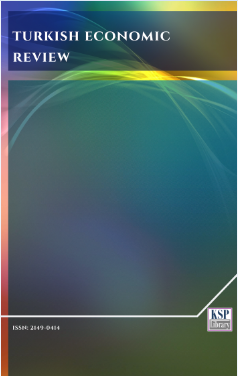Lumping together democracy and dictatorship: Has macro dynamics of poverty remained steady in Pakistan
Abstract
Abstract. In this study we check the relationship between macroeconomics variables with poverty. We select head count ratio proxy of poverty as dependent variable and GDP, unemployment rate, literacy rate, rural population and worker remittances as independent variables. For the analysis of the data we take time series data from 1978-2011 and established the long run and short run relationship between dependent and independent variables. First of all we check the normality of the data by descriptive statistics, further we check the stationarity of the data by applying ADF test. For long run relationship between dependent and independent variables we applied FMOLS techniques and relationship in short run checked by EMC methods. Results of the data shows, macroeconomic variables especially literacy rate and rural population have been major factors that affect poverty levels in Pakistan. GDP has a negative and insignificant impact on poverty. Literacy rate is positivly and significantly related with poverty. Worker remittances have negative and significant impact on poverty, while rural population has negative and significant impact on poverty. Unemployment has positive and insignificant impact on poverty in Pakistan.
Keywords. Poverty, Macro economy, Capability.
JEL. E20, E22, E29.Keywords
References
Acharya, C., & Leon-Gonzalez, R. (2012). The impact of remittance on poverty and inequality: A micro-simulation study for Nepal. National Graduate Institute for Policy Studies, 1-32. [Retrieved from].
Adams, R., & Page, J. (2005). Do international migration and remittances reduce poverty in developing countries? World Development, 33(10), 1645-1669. doi. 10.1016/j.worlddev.2005.05.004
Afzal, M., Malik, M.E., Begum, I., & Sarwar, K. (2011). Relationship among education, poverty and economic growth in Pakistan: An econometric analysis. Journal of Elementary Education, 22(1), 23-45.
Ali, S.S., & Tahir, S. (1999). Dynamics of growth, poverty and inequality in Pakistan. The Pakistan Development Review, 38(4), 837-858.
Anwar, T. (2010). Role of growth and inequality is explaining changes in poverty in Pakistan. Pakistan Development Review , 49(1), 1-17.
Bigsten, A., & Levin, J. (2000). Growth, income and poverty. Department Of Economics Goteberg University . [Retrieved from].
Fosu, A.K. (2010). Does economic growth reduces poverty. UN University-World Institute For Development , 1-58.
Gyimah-Brempong, K., & Asiedu, E. (2009). Remittances and poverty in Ghana. African Economic Conference (AEC), 1-35. [Retrieved from].
Islam, R.U. (2004). The Nexus of economic growth employment and poverty reduction. International Labour Office Geneva , No.14. 1-39. [Retrieved from].
Javid, M., Arif, U., & Qayyum, D.A. (2012). Impact of remittances on economic growth and poverty, Academic Research International, 2(1), 1-15.
Khan, S., & Lavison, D. (2007). The impact of population growth on economic growth and poverty reduction in Uganda. [Retrieved from].
Mahmood, M. (2005). Poverty reduction in Pakistan:. Policy Integration Department, Workin Paper, No.16. [Retrieved from].
Mallik, S., & Ghani, N. (2005). A review of the relationship between poverty, population growth and environment. Pakistan Development Review , 44(4), 597-614.
Njomg, A.M. (2010). The effects of educational attainment on poverty reduction in Cameroon. Journal of Education Administration And Plolicy Studies, 2(1), 1-8. doi. 10.5897/IJEAPS10.058
Osinubi, T.S. (2005). Macro econometric analysis of growth, unemployment and poverty in Nigeria. Pakistan Economic and Social Review, 43(2), 249-269.
Roemer, M., & Gugerty, M.K. (1997). Does economic growth reduces poverty. Harwar Institute For International Development, 1-33. [Retrieved from].
Sabir, H.M., & Tahir, S.H. (2012). The impact of different macroeconomics variables on poverty in Pakistan. Interdisciplinary Journal of Contemporary Research in Business, 3(10), 1-12.
Sackey, H.A., & Osei, B. (2006). Human resources underutilization in an era of poverty reduction: An analysis of unemployment and under employment in Ghana. Africa Development Review, 18(2), 221-247.
Stephen, B.A. (2011). A critical appraisal of the linkage between literacy rate and the incidence of poverty in Nigeria. Journal of Emerging Trends in Education Research and Policies Studies, 2(6), 450-456.
Zaman, K., Shah, I.A., & Khan, M.M. (2011). Exploring the link between poverty-pollution-population (3Ps). Journal of Economics and Sustainable Development, 2(11-12), 27-50.
Zamurrad, P., & Kamal, U.A. (2011). The role of education and income in poverty elevation. The Lahore Journal Of Economics, 16(1), 143-172.
DOI: http://dx.doi.org/10.1453/ter.v5i3.1714
Refbacks
- There are currently no refbacks.
.......................................................................................................................................................................................................................................................................................................................................
Turkish Economic Review - Turk. Econ. Rev. - TER - www.kspjournals.org
ISSN: 2149-0414
Editor: [email protected] Secretarial: [email protected] Istanbul - Turkey.
Copyright © KSP Library




